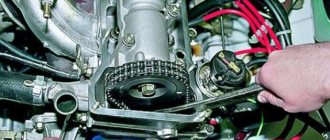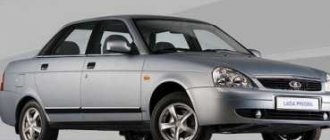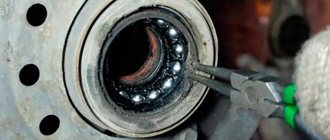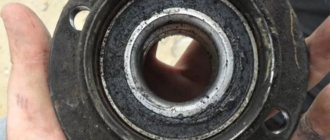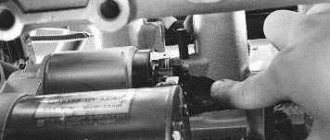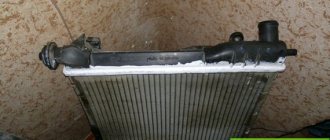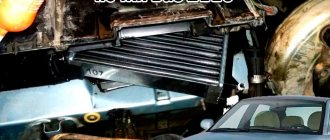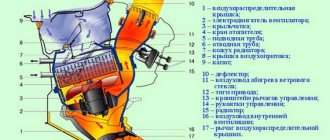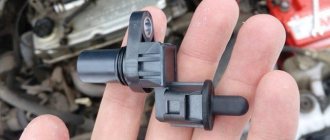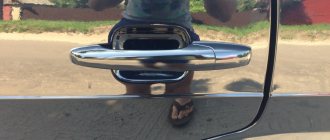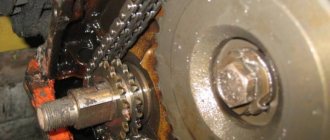Replacing the camshaft of VAZ 2107, VAZ 2106 with your own hands
The camshaft (camshaft) is one of the most important elements of the gas distribution mechanism (GRM).
The camshaft's job is to ensure timely intake of clean air and exhaust of exhaust gases from the combustion chamber by opening and closing the intake and exhaust valves. The camshaft is located in the upper part of the cylinder head (cylinder head), the crankshaft is connected to a pulley and a toothed sprocket using a timing chain or belt.
The main malfunctions that require repair or replacement of the camshaft include increased wear, scratches and risks on the camshaft bearing journals, numerous scuffs or camshaft deflection (deformation).
Loss of pressure in the engine lubrication system. As a rule, the cause of this is severe wear of the camshaft journals, as well as in the event of a violation of the camshaft bearing seats in the cylinder head. The second case requires a complete replacement of the cylinder head, due to the fact that the sockets are located in the cylinder head body itself.
Strong knocking of valves in the presence of working hydraulic compensators, increasing gaps in the valve drive mechanism. The reason is increased wear on the camshaft cams, the use of low-quality engine oil, and a non-working or clogged oil filter. These malfunctions are also characterized by loss of power and interruptions in engine operation.
Also, the camshaft is replaced in the case of engine tuning, when the standard camshaft is replaced with a sports one with radically different characteristics, intake/exhaust phases and slightly modified cams. This is necessary to increase power or improve the efficiency (efficiency) of the motor.
Today I will talk about how to replace the camshaft of a VAZ 2107, VAZ 2106 with your own hands, using improvised tools in a garage.
If the camshaft fails
The camshaft on the VAZ 2106 model is rarely dismantled. Typically during repair or disassembly. Sometimes to replace it.
Signs
First, let's talk a little about the signs that indicate that the camshaft is faulty, its journals or beds are worn out. It is difficult to determine whether the shaft or something else is knocking in the VAZ 2106 engine, but it is possible. The knock of the camshaft is dull and clearly audible. As engine speed increases, the knocking becomes more frequent.
Some drivers determine knocking in this unit using a stethoscope or a stick through the valve cover. But often it is difficult for an inexperienced driver to do this. Therefore, the best way to diagnose the camshaft is to remove it, wash it and inspect it.
If the camshaft is faulty, the following symptoms may occur:
- a dull knock, reminiscent of hammer blows;
- it is impossible to adjust the valve clearances; while the crankshaft is turning, the camshaft is constantly in different positions.
This video shows how you can eliminate longitudinal runout of a camshaft.
The most reliable method for diagnosing problems with the VAZ 2106 camshaft is to dismantle it from the car and wash it. You can wash it in gasoline or other cleaning liquid. Next, you need to hold the shaft and hit the bed, when you hear the slightest knock, we determine whether the mechanism is worn out. Be sure to make sure that the shaft does not move in bed, because when it hits the limiter it will make a dull knock.
Removed shaft
The camshaft has a great influence on the pressure in the lubrication system. If the gaps between the bed and the camshaft are large, then the pressure will be low, and as a result, unsatisfactory lubrication of other parts.
Causes
The main malfunctions that result in the need to replace the camshaft are its wear, the appearance of various scuffs and grooves on the bearing journals. Likewise, replacing the camshaft is necessary if it is found to be deformed or cracked. When such malfunctions occur, the power unit loses power and also begins to function intermittently. Problems with the camshaft are identified by a knocking sound in the cylinder head.
The camshaft on the “six” is rarely removed. In addition to the above reasons for replacing and reconfiguring the power unit. After this, you can notice a significant increase in power, like in sports cars.
Replacing the camshaft VAZ 2107, VAZ 2106 - step-by-step instructions.
2. Set the camshaft to the end of the compression stroke of the 4th cylinder.
3. Using a “13” wrench, release the chain tensioner, then resting the assembly against the tensioner shoe, squeeze the tensioner rod tightly, then secure it using the chain tensioner nut. If something doesn't work, then remove the tensioner completely.
4. Take a flathead screwdriver and carefully bend the lock washer on the camshaft sprocket bolt.
5. Engage fourth gear, this will fix the camshaft and save you from turning it.
6. Next, take the key to “17” and unscrew the sprocket mounting bolt.
7. Remove the camshaft mounting bolt along with washers, sprocket and chain. It is best to fasten the chain to the sprocket using thread; this will save you from the chain jumping on the sprocket teeth, which is extremely undesirable.
8. Using a key set to “13”, unscrew the 9 nuts of the camshaft “bed”.
9. Now dismantle the camshaft along with the “bed” by removing it from the studs.
10. Unscrew the two mounting bolts of the thrust flange using a “10” wrench, then remove the flange itself.
11. Lift the cam to release it from spring pressure, then remove it.
12. Now you can remove the camshaft from the “bed”.
13. Remove the cam spring.
This concludes the disassembly, now you can replace the camshaft of the VAZ 2107, VAZ 2106. Assembly is carried out in the reverse order.
Important point. Tighten the camshaft bed mounting nuts in strict accordance with the diagram below.
Bolts in VAZ family cars
Fasteners are presented in a wide range, they have different sizes and purposes. For example, the rear door shock absorber mounting bolt 2108-09 or the roof support mounting bolt. If you are repairing a generator, you will also need the appropriate fastener. Even to fix a ball license plate, certain hardware is needed.
The photo shows the cylinder head bolts of a VAZ 2108.
Bolts for alloy wheels
VAZ wheel bolts are designed for fixing alloy wheels, the total length is 51 mm. Approximate cost of elements:
- a VAZ M 12×30.5 wheel bolt costs from 35 rubles;
- secret bolts for VAZ-2101-12 set – 280 rubles;
- wheel hardware M12×1, 25×28 zinc from 45 RUR/piece;
- The eccentric bolt on the VAZ (shown in the photo) allows you to install any wheels with a 4×100 drill bit.
Wheel bolts on VAZ for alloy wheels have a thread length of 28, 30 and 33 millimeters. Standard factory fasteners come with dimensions of 12×1.25 with a total length of 44 mm and a thread length of 24 mm.
Transmission mounting bolt
M12×45 brand fasteners are suitable as standard parts for transmissions and gearboxes on VAZ 2101, 2102, 2103, 2104, 2105, 2106, 2107 models. For VAZ gearboxes, M 12×1.24 Belebey fasteners are used.
Arm bolts
A broken beam bolt (rear suspension arm) is usually discovered when trying to perform wheel alignment. The result is a discovered lever that is not properly secured. On VAZ cars, there are no problems replacing the upper arm, since the fasteners are clearly visible and easy to reach. Bend the pressing petal and knock out the 14x243 element. You will have to work longer with the rear fasteners, since you have to remove the hardware through the lower hole in the beam. It is recommended to use a screwdriver or tweezers as tools.
Using available tools, install new bolts. When replacing, do not dismantle the lower arm. When one hardware is unscrewed and removed, the second one must be fully tightened. This will allow fastening without distortion of the lower axis. It is recommended to have a jack on hand, which should be placed under the lower arm mount and at the same time adjust its position. This technique will lighten the load on the bolt and simplify installation.
Camber bolts
With frequent use of the vehicle, the camber bolts stretch, resulting in a change in the alignment angle of the front wheels. In this case, the problem with stuck fasteners is detected on alignment/camber when the thread breaks. Car owners often ask the question: why change the camber bolts? The M12×1.25 hardware has a fine thread. Due to corrosion processes and repeated unscrewing, the thread profile wears out. With each subsequent installation, the risk of stripping the thread increases. It is recommended to replace the kit to avoid unpleasant situations with broken threads during camber.
Coolant drain bolt
To drain the coolant from the engine compartment, unscrew the special drain bolt. It is located on the left side. The tools you will need are a 13mm wrench.
Diagnostics and replacement of the camshaft on a VAZ 2107
The camshaft, like any important component of an engine's design, affects its performance. Even minor defects in this device can negatively affect the engine power and its traction characteristics. This may also lead to unreasonably high gas mileage, and in the long run will lead to serious breakdowns requiring expensive repairs.
Next, we will discuss why a distribution valve is needed on the VAZ 2107, how to diagnose it and troubleshoot it yourself.
Timing shaft diagnostics
In the removed state, you can easily assess what defects are on the shaft. Visually, you can detect damage such as scuffs and scratches, as well as wear on the cut on the cams and coating of the aluminum word on the necks.
Even if minor traces of deformation were noticed, the camshaft on the VAZ 2107 must be replaced.
We present a table that shows the permissible values of the dimensions of the shaft journals for its further use.
| Part number (report starts at the front) | Threshold of permissible size values, mm | |
| Minimum | Maximum | |
| Shakey | ||
| 1 | 45,91 | 45,93 |
| 2 | 45,61 | 45,63 |
| 3 | 45,31 | 45,33 |
| 4 | 45,01 | 45,03 |
| 5 | 43,41 | 43,43 |
| Supports | ||
| 1 | 46,00 | 46,02 |
| 2 | 45,70 | 45,72 |
| 3 | 45,40 | 45,42 |
| 4 | 45,10 | 45,12 |
| 5 | 43,50 | 43,52 |
If these values are not met, it is important to replace the “bed” or timing shaft.
Purpose and principle of operation
The camshaft is a metal rod on the axis of which eight cams are placed. These are parts that have an irregular shape. They rotate on the axis of the camshaft and are located opposite the inlet valves of the cylinders. Their rotation ensures stable combustion of the fuel mixture inside the cylinders. All these mechanisms are brought into precise synchronization.
Thanks to the proper operation of the shaft, a mixture of air and fuel is released into the cylinders in a timely manner, compression and release of exhaust gases occurs. On the Classic, the camshaft is driven by the fact that its gear rotates as a result of interaction with the crankshaft sprocket through a chain.
On the VAZ 2107, the camshaft is located at the top above the cylinder block. Thanks to this, it is available for self-replacement. This also makes it possible to easily adjust valve clearances.
To better understand the principle of operation of the camshaft, watch the video tutorial.
Functions and design of the camshaft
The VAZ 2107 camshaft (injector and carburetor) synchronizes the operation of the intake and exhaust valves with the position of the pistons in the engine cylinders. It opens the exhaust valves to release exhaust gases and the intake valves to fill the combustion chambers with an air-fuel mixture. The “seven” uses an engine layout with an overhead camshaft. This reduces the cost of construction and makes the maintenance process easier. The VAZ 2107 camshaft is connected to the engine crankshaft via a chain driven by a sprocket. As the camshaft rotates, the cams located on it press on the rocker and open (close) the valves at the right moment. The camshaft bearing journals rotate in the bearings of the “bed” installed in the engine head. Lubricant from the oil pump is supplied to them through the oil channels, so the condition of the camshaft affects the pressure in the engine lubrication system.
Why install a different camshaft?
The main reason for installing a new part is to replace it in case of failure. But sometimes such a decision is made for other reasons. For example, a car owner dreams of improving engine performance. And for this he begins to tune the engine. It is believed that a more advanced camshaft can help improve engine performance.
How is this achieved? Another device may make it possible to increase the valve lift and the width of the engine's operating phase. In theory, this should help produce more mixture, which will improve performance.
And there are so many things that numerous “amateurs” are trying to cram into the cylinder head. But there is only one car that can become a “donor” for installing a new device. And this is everyone’s favorite Niva (VAZ 21213). The Niva camshaft is an ideal solution for tuning the 7 engine!
The phase width of this part, as well as its intake valve lift, are relatively suitable for the operation of the Seven engine. And the engine receives an increase in power of about 2 horsepower. Of course, this is not such a big deal. But at the start the car responds a little better.
If a car enthusiast is willing to pay money for a special “sports” shaft, then he may well buy one that is manufactured in domestic factories for this purpose. Today you can find a worthy “comrade” within 10 thousand rubles.
Causes and types of malfunctions
During its operation, the timing shaft is constantly exposed to high temperatures and high dynamic loads. Therefore, it inevitably loses its properties and fails. When this happens, the driver begins to feel that the engine is losing power, and under load, a slight knocking noise occurs in the engine. If this happens, it's time to open the cylinder head.
So what could happen?
- The cams or journals are worn out. Any part that rotates during its operation will naturally begin to wear out over time. The wear process can be accelerated by low oil pressure or poor quality, as well as manufacturing defects of the part itself. Worn cams cannot lift the intake valve properly, resulting in less fuel entering the cylinder than needed.
- Camshaft deformation. Severe overheating of the engine, which occurs when the lubrication is not working well or when there are problems in the cooling system, leads to this type of breakdown. The malfunction can be identified by a characteristic knocking sound. It is prohibited to operate the car in this case - otherwise you can easily damage the operation of the entire gas distribution mechanism.
- Shaft fracture. Sometimes it happens that the camshaft simply breaks, which may be a consequence of desynchronization in the timing system. The engine stops working, the valves become bent, the guides are damaged, and the piston group mechanisms are destroyed.
How to remove the camshaft
Diagnostics, repairs and measurements of the shaft are carried out only after it is removed from the engine. To work, you need to prepare 13 mm and 10 mm socket wrenches, 17 mm open-end and torque wrenches, as well as pliers.
Dismantling is carried out in the following sequence:
- The car starts on a level surface.
- The air filter housing is removed.
- Using pliers, the throttle cable is removed from the carburetor, as well as the longitudinal rod of the throttle valve.
- It is better to move the fuel hose to the side and secure it.
- Using a 10mm wrench, you need to unscrew the fastenings of the chain tensioner to the cylinder head and remove it.
- Using a 10mm wrench, unscrew the nuts that secure the valve cover.
- Now the cover is easily removed, and after it the rubber gasket is also removed.
- Using a slotted screwdriver, you need to straighten the lock washer, which is located in the place where the shaft star is attached.
- To perform the following work, you need to put the gearbox in first speed. Then you can use a 17mm wrench to unscrew the bolt that secures the camshaft gear.
- Now it is easy to remove it along with the chain.
- Now is the time to remove all the nuts that secure the camshaft to the bed. The key to 13 will help us with this.
- Now the camshaft is easy to remove along with the “bed”.
- Using a 10mm wrench, unscrew the bolts that secure the flange and the flange is disconnected.
- The camshaft is now easy to remove from the “bed”.
Preparatory stage
To set the ignition on a VAZ 2107 , no special conditions are required; the operation can be done both in the garage and on the street, including in winter. For work, prepare the following set of tools:
- flat screwdriver;
- metal probe 0.35 mm thick;
- open-end wrench size 13 mm;
- a car light bulb designed for a voltage of 12 V with wires soldered to it;
- a wrench with a long handle designed to turn the crankshaft;
- key for unscrewing spark plugs.
Note. Instead of a special key to rotate the crankshaft, you can use a regular open-end wrench measuring 36 mm. If you don’t have such a key, then you will have to set the marks in the old proven way: by engaging 4th gear and raising the rear wheel, turn it manually, thereby turning the crankshaft.
Ideally, it is better to have in your arsenal a device for setting the ignition on a running engine - a strobe light. It is equipped with a lamp that flashes simultaneously with the moment of spark formation in the cylinder, which allows you to see the position of the notch on the crankshaft pulley at idle speed and clearly adjust the advance angle.
Important point. The ignition is set in order to ensure that the spark appears in a timely manner and the engine starts, after which additional adjustments will be required. But the latter will not bring you the desired result when there is no compression in the cylinders or problems with the carburetor make themselves felt. If these faults are not eliminated, the engine operation will remain unstable, no matter how you configure the spark generation system.
Hence the conclusion: you can set the ignition correctly at any time, but to set it well - only on a working engine and carburetor.
ICE theory: Motor 2103 with head 21214 with reg. star (modern)
2:17 — How to measure compression 9:55 — How to install an adjustable sprocket 10:00 — How to set up a split gear.
VAZ 2107 injector - treatment of tripping and misfires
Diagnostics revealed that the fourth gasoline injector was clogged, tripping and multiple misfires in all.
Basic functions of the camshaft
The camshaft opens and closes the valves, allowing the fuel mixture into and out of the cylinder. There are cams on the camshaft. These are the protrusions that transmit torque to the levers. One arm of the rocker (lever) receives torque from the camshaft, the other transmits it to the valves. Thus, the valves open. When the cam rotates further, it stops acting on the rocker, and the springs return the valve to its original position, that is, it closes. The camshaft is driven by the action of the crankshaft. They are connected by a timing chain or belt. If we draw an analogy with a bicycle, then the crankshaft is the pedals, the camshaft is the rear wheel, and the timing chain is the same on a two-wheeler. While the crankshaft makes two revolutions, the camshaft makes only one.
How to understand that the camshaft needs to be changed?
You can determine a camshaft malfunction without opening the hood by two signs:
- knock;
- reduction in engine oil pressure.
The main reason for malfunctions in the camshaft is the appearance of gaps. They appear between the shaft bearing journals and the bed bearings on which the camshaft rests. The cracks are formed due to the fact that parts of the camshaft are worn away. Gaps cause the shaft to move in the vertical or horizontal axis. If the shaft play is 1 mm, then this affects the operation of the engine. Reasons for gaps:
- the camshaft was not replaced in a timely manner;
- do not change the oil on time;
- use of low-quality oil;
- the driver drives at low speeds, so little oil enters the timing belt and parts wear out faster.
The camshaft also needs to be changed if the oil channels in it are clogged. Before changing the part, look for any play, fracture, deformation or scuffing of the shaft.
Camshaft knock: what to do
If the camshaft begins to knock on the car, the driver should be prepared to incur significant costs. At the same time, we are not talking about replacing the camshaft, since faulty hydraulic compensators or bearings can also cause detonation. Based on this, we can conclude that if there is a suspicion of knocking in the camshaft, you should send the car for diagnostics as soon as possible. It is quite possible that this will reveal not only problems in the units responsible for synchronizing the engine clocks, but also in other elements.
READ How to Remove Honda Fit CVT
It is important to note that by delaying diagnosis, the driver risks increasing the cost of repairs. If the hydraulic jacks begin to fail, the camshaft may not function properly. Based on this, the sooner the diagnosis is made and the cause of camshaft detonation is determined, the less likely it is to fail.
Cars that are not equipped with hydraulic lifters can drive more than 50,000 kilometers with camshaft shock, but after that you may need a complete engine replacement or overhaul.
How to choose quality parts
Buy a camshaft from a reliable and time-tested company, for example, PJSC Avtovaz. The packaging has a seal with a hologram. It shimmers in the light and features the company's logo. There is also a sticker with a barcode on the box. The item is packaged in blue translucent film. There is a stamp from the Quality Control department inside the package. Buy rockers together with adjusting bolts. There are new and old style levers. The holes in them differ in diameter and number of cuts. If you buy rockers and bolts separately, chances are they won't fit together.
Removing the camshaft
The engine must be cold when replacing the camshaft. You will need:
- New camshaft;
- Set of levers with bolts;
- Wrenches for 7, 8, 10, 13, 17 and 24;
- Small and large screwdriver;
- 3 spare lever springs;
- Rail;
- Valve cover gasket;
- Torque wrench
- Remove the air filter, separate the tip, cable and throttle linkage.
- If you have a carburetor engine, remove the fuel hose from the bracket; if you have an injection engine, disconnect the vacuum hose, air supply hose and remove the fuel filter from the bracket.
- Remove the cylinder block cover.
- Align the mark on the camshaft sprocket with the top dead center of the 4th cylinder. If you have a carburetor engine, you can turn the crankshaft with a special wrench. And if there is an injector, then you need to jack up the car, engage fourth gear and spin the rear wheel.
- Remove the gasket.
- Bend the camshaft sprocket washer with a chisel.
- Engage fourth gear to lock the crankshaft.
- Remove the tensioner.
- Unscrew the nut and remove the star. Tie the chain to the sprocket so that the links do not jump to other teeth.
- Unscrew the nuts and pull out the camshaft.
- Remove the rocker, bolts and springs.
Appendix 1. Tightening torques for threaded connections* VAZ 2107 Zhiguli
- Repair manuals
- Repair manual for VAZ 2107 (Zhiguli) 1982+.
- Appendix 1. Tightening torques for threaded connections*
| Tightening torque, N m (kgf m) | ||||
| Detail | Thread | nominal | minimum | maximum |
| Engine | ||||
| Main bearing cap bolt | M10x1.25 | 80,36(8,2) | 68,31(6,97) | 84,38(8,61) |
| Oil sump bolt | M6 | 7,80(0,8) | 5,10(0,52) | 8,20(0,85) |
| Breather cover mounting stud | M8 | 19,6(2,0) | 12,70(1,3) | 20,60(2,1) |
| Breather cover nut | M8 | 19,6(2,0) | 12,70(1,3) | 20,60(2,1) |
| Cylinder head bolt: | M12x1.25 | |||
| pre-tightening | 39,2(4,0) | 33,3(3,4) | 41,16(4,2) | |
| final tightening | 112,7(11,5) | 95,94(9,79) | 118,38(12,08) | |
| Cylinder head bolt | M8 | 25,5(2,6) | 21,6(2,2) | 26,75(2,73) |
| Nut securing inlet and outlet pipelines | M8 | 24,5(2,5) | 20,87(2,13) | 25,77(2,63) |
| Connecting rod cap bolt nut | M9x1 | 50,96(5,2) | 43,32(4,42) | 53,51(5,46) |
| Flywheel bolt | M10x1.25 | 83,3(8,5) | 60,96(6,22) | 87,42(8,92) |
| Tensioner roller bolt* | M8 | 29,4(3,0) | 24,5(2,5) | 34,3(3,5) |
| Chain tensioner shoe bolt | M10x1.25 | 48,0(4,9) | 41,2(4,2) | 51,0(5,2) |
| Camshaft bearing housing stud nut | M8 | 21,56(2,2) | 18,33(1,87) | 22,64(2,3) |
| Camshaft sprocket bolt | M10x1.25 | 48,0(4,9) | 41,2(4,2) | 51,0(5,2) |
| Oil pump drive shaft sprocket bolt | M10x1.25 | 48,0(4,9) | 41,2(4,2) | 51,0(5,2) |
| Adjustment bolt nut | M12x1.25 | 50,96(5,2) | 43,3(4.42) | 53,5(5,46) |
| Camshaft pulley and oil pump drive shaft bolts* | M10x1.25 | 78,4(8,0) | 66,64(6,8) | 82,32(8,4) |
| Valve adjusting bolt bushing | M18x1.5 | 98(10) | 83,3(8,5) | 102,9(10,5) |
| Spark plug | M14x1.25 | 37,24(3,8) | 30,67(3,13) | 39(3,99) |
| Coolant pump mounting bolt | M8 | 25,48(2,6) | 21,66(2,21) | 26,75(2,73) |
| Nut of the stud securing the exhaust pipe of the cooling jacket | M8 | 21,56(2,2) | 15,97(1,63) | 22,64(2,31) |
| Crankshaft ratchet | M20x1.5 | 119,6(12,2) | 101,3(10,3) | 125,6(12,8) |
| Generator bracket mounting bolt | M10x1.25 | 58,8(6,0) | 44,1(4,5) | 64,7(6,6) |
| Generator mounting bracket nut | M10x1.25 | 43,12(4,4) | 28,63(2,86) | 45,27(4,62) |
| Nut securing the generator to the bracket | M12x1.25 | 68,6(7,0) | 58,3(5,95) | 72(7,35) |
| Nut securing the mounting plate to the generator | M10x1.25 | 43,12(4,4) | 28,08(2,86) | 45,3(4,62) |
| Nut securing the cushion to the front support bracket | M10x1.25 | 33,3(3,4) | 21,6(2,21) | 35(3,57) |
| Nut securing the front engine mount to the cross member | M10x1.25 | 32,3(3,3) | 27,4(2,8) | 34(3,46) |
| Nut securing the plate to the pillow | M6 | 8,8(0,9) | 5,7(0,58) | 9,2(0,94) |
| Nut securing the rear engine mount to the body | M8 | 17,6(1,8) | 15(1,53) | 18,6(1,9) |
| Nut securing the rear support to the gearbox | M8 | 27,4(2,8) | 23,3(2,38) | 28,8(2,94) |
| Nut of the bolt securing the rear support to the cross member Electric fan switch sensor | M8 M22x1.5 | 24,5(2,5) 47,0(4,8) | 15,9(1,62) 40,0(4,08) | 25,7(2,62) 49,4(5,04) |
| Clutch _ | ||||
| Clutch bolt | M8 | 29,4(3,0) | 19,1(1,95) | 30,9(3,15) |
| Clutch and brake pedal mounting bolt nut | M12x1.25 | 19,6(2,0) | 12,7(1,3) | 20,6(2,1) |
| Clutch and brake master cylinder nuts | M8 | 14,7(1,5) | 9,8(1,0) | 15,7(1,6) |
| Connection of hydraulic brake pipes | M10 | 17,6(1,8) | 14,7(1,5) | 18,6(1,9) |
| Connection of hydraulic clutch tubes | M12 | 29,4(3,0) | 24,5(2,5) | 31,4(3,2) |
| Transmission | ||||
| Reversing light switch | M14x1.5 | 43,1(4,4) | 28,4(2,9) | 45,1(4,6) |
| Bolts securing the clutch housing to the engine | M12x1.25 | 83,3(8,5) | 53,9(5,5) | 87,2(8,9) |
| Nut securing the clutch housing to the gearbox | M10x1.25 | 49(5,0) | 31,8(3,25) | 51,4(5,25) |
| Nut securing the clutch housing to the gearbox | M8 | 24,5(2,5) | 15,7(1,6) | 25,5(2,6) |
| Bolt securing the rod clamp cover | M8 | 24,5(2,5) | 15,7(1,6) | 25,5(2,6) |
| Rear cover fastening nut | M8 | 24,5(2,5) | 15,7(1,6) | 25,5(2,6) |
| Nut of the rear end of the driven shaft | M20x1 | 78,4(8,0) | 66,6(6,8) | 82,3(8,4) |
| Intermediate Shaft Bearing Clamp Washer Bolt | M12x1.25 | 93,1(9,5) | 79,4(8,1) | 98(10) |
| Bolt securing the fork to the gearshift rod | M6 | 17,6(1,8) | 11,7(1,2) | 18,6(1,9) |
| Cardan transmission | ||||
| Front propeller shaft fork nut | M16x1.5 | 93,1(9,5) | 79,4(8,1) | 98(10) |
| Nuts of bolts securing the elastic coupling | M12x1.25 | 67,6(6,9) | 57,8(5,9) | 71,5(7,3) |
| Nut of the bolt securing the propeller shaft flange to the gearbox flange | M8 | 32,3(3,3) | 27,4(2,8) | 34,3(3,5) |
| Rear axle | ||||
| Gearbox mounting bolt | M8x1.25 | 41,2(4,2) | 35(3,57) | 43,2(4,41) |
| Differential bearing cover bolt | M10x1.25 | 51(5,2) | 43,3(4,42) | 53,5(5,46) |
| Driven gear bolt | M10x1.25 | 98(10) | 83,3(8,5) | 102,9(10,5) |
| Nut securing the flange to the drive gear | M16x1.5 | See subsection "Rear Axle" | ||
| Nut for the mounting plate of the axle shaft bearing and brake shield | M10x1.25 | 49(5,0) | 41,6(4,25) | 51,4(5,25) |
| Steering | ||||
| Steering housing mounting bolt nut | M10x1.25 | 39,2(4,0) | 33,3(3,4) | 41,2(4,2) |
| Nut of a bolt of fastening of a bracket of the pendulum arm | M10x1.25 | 39,2(4,0) | 33,3(3,4) | 41,2(4,2) |
| Steering linkage ball pin nut | M14x1.5 | 50(5,1) ** | 42,1(4,3) | 53(5,4) |
| Bolt securing the intermediate shaft to the upper shaft and to the worm shaft | M8 | 26,5(2,7) | 22,5(2,3) | 27,4(2,8) |
| Steering wheel nut | M16x1.5 | 49(5,0) | 31,4(3,2) | 51(5,2) |
| Nut securing the steering shaft bracket and switch | M8 | 17,6(1,8) | 15(1,53) | 18,6(1,9) |
| ignition | ||||
| Bipod fastening nut | M20x1.5 | 235,2(24) | 199,9(20,4) | 247(25,2) |
| Pendulum arm axle nut | M14x1.5 | 98(10) | 63,7(6,5) | 102,9(10,5) |
| Front suspension | ||||
| Bolt securing the cross member to the body side member | M12x1.25 | 93,1(9,5) | 78,4(8,0) | 98(10) |
| Nut of the lower bolts securing the cross member to the body side member | M12x1.25 | 78,4(8,0) | 66,6(6,8) | 82,3(8,4) |
| Nut of the lower arm axle mounting bolt | M12x1.25 | 78,4(8,0) | 66,6(6,8) | 82,3(8,4) |
| Lower arm axle nut | M14x1.5 | 98(10) | 63,7(6,5) | 103(10,5) |
| Upper arm axle nut | M14x1.5 | 88,2(9,0) | 57,3(5,85) | 92,1(9,4) |
| Nut securing the upper end of the shock absorber | M10x1.25 | 32,3(3,3) | 27,4(2,8) | 34(3,46) |
| Nut securing the lower end of the shock absorber | M10x1.25 | 58,8(6,0) | 50(5,1) | 62(6,3) |
| Front wheel hub bearing nut | M18x1.5 | See section "Chassis" | ||
| Bolt securing the caliper to the bracket | M10x1.25 | 34,3(3,5) | 29,1(3,0) | 36(3,7) |
| Anti-roll bar mounting nut | M8 | 17,6(1,8) | 15,0(1,53) | 18,6(1,9) |
| Nut securing ball pins to steering knuckle | M14x1.5 | 98(10) | 83,3(8,5) | 103(10,5) |
| Wheel bolt | M12x1.25 | 68,6(7,0) | 58,8(6,0) | 72,0(7,35) |
| Steering knuckle bolt nut | M10x1.25 | 58,8(6,0) | 50(5,1) | 61,74(6,3) |
| Rear suspension | ||||
| Shock absorber mounting nuts | M12x1.25 | 58,8(6,0) | 38,2(3,9) | 61,7(6,3) |
| Nuts of bolts for fastening transverse and longitudinal rods | M12x1.25 | 78,4(8,0) | 66,6(6,8) | 82,3(8,4) |
* For VAZ-2105 engines.
** If the nut cutout does not coincide with the hole for the cotter pin, retighten the nut (at an angle less than 60°)
to ensure its cotter pinning.
↓ Comments ↓
1. Vehicle operation and maintenance
1.0 Operation and maintenance of the vehicle 1.1. Vehicle operation 1.2 Vehicle maintenance
2. General information
2.0 General data 2.1 Technical characteristics of vehicles 2.2 Controls and monitoring devices 2.3. Ventilation control and interior heating
3. Engine
3.0 Engine 3.1 Removal and installation of the engine 3.2 Disassembling the engine 3.3 Possible engine malfunctions, their causes and methods of elimination 3.4 Engine assembly 3.5 Bench tests of the engine 3.6 Checking the engine on a car 3.7. Cylinder block 3.8. Pistons and connecting rods 3.9. Crankshaft and flywheel 3.10. Cylinder head and valve mechanism 3.11. Camshaft and its drive 3.12. Cooling system 3.13. Lubrication system 3.14. Supply system
4. Transmission
4.0 Transmission 4.1. Clutch 4.2. Gearbox 4.3. Cardan transmission 4.4. Rear axle
5. Chassis
5.0 Chassis 5.1. Front suspension 5.2. Rear suspension 5.3. Shock absorbers
6. Steering
6.0 Steering 6.1. Inspection, check and adjustment of steering 6.2. Steering mechanism 6.3. Steering rods and ball joints 6.4. Swing arm bracket
7. Brakes
7.0 Brakes 7.1. Checking and adjusting the brakes 7.2 Possible malfunctions of the brakes, their causes and methods of elimination 7.3 Bracket for the clutch and brake pedals 7.4. Vacuum booster 7.5. Brake master cylinder 7.6. Front brakes 7.7. Rear brakes 7.8. Rear brake pressure regulator 7.9. Parking brake
8. Electrical equipment
8.0 Electrical equipment 8.1 Electrical equipment diagram 8.2. Battery 8.3. Generator 8.4. Starter 8.5. Ignition system 8.6. Lighting and light signaling 8.7. Sound signals 8.8. Windshield cleaner 8.9 Headlight cleaner 8.10. Heater electric motor 8.12. Control devices
9. Body
9.0 Body 9.1. Doors 9.2 Possible body malfunctions, their causes and methods of elimination 9.3. Hood, trunk lid, bumpers 9.4. Body glazing 9.5. Windshield and headlight glass washers 9.6. Instrument panel 9.7. Seats 9.8. Heater and ventilation of the body interior 9.9. Body frame repair 9.10. Paint and varnish coatings 9.11. Anti-corrosion protection of the body
10. Modification and equipment of VAZ-2107 cars
10.0 Modification and equipment of VAZ-2107 vehicles 10.1. Car VAZ-21072 10.2 Car VAZ-21074 10.3. Car VAZ-21073-40
11. Applications
11.0 Appendices 11.1 Appendix 1. Tightening torques for threaded connections* 11.2 Appendix 2. Tools for repair and maintenance* 11.3 Appendix 3. Used fuels and lubricants and operating fluids 11.4 Appendix 4. Basic data for adjustment and control 11.5 Scheme
Installing a new shaft
The new camshaft must be lubricated with engine oil before installation.
- Check the lever springs. If they are broken or bent, replace them.
- Screw the adjustment bolts into place.
- Install the springs, then attach the rocker to them.
- Now you can insert the camshaft with housing. Lubricate the levers, cams and journals of the camshaft with oil. Fit them on and tighten them with a torque wrench. The procedure is performed from the center to the edge. Tightening torque – 2 kgf*m.
The diagram for tightening the VAZ 2107 camshaft nuts is in the photo
Diagram of the camshaft nut tightening order
Installing a new camshaft
In order to install a new timing shaft, you will need the same tools as to dismantle it. The installation procedure is as follows:
- Be sure to lubricate the surfaces of the cams, bearing journals and bearings with engine oil.
- We install the camshaft in the “bed”.
- Using a 10 mm wrench, tighten the bolts of the thrust flange.
- We check how the shaft rotates. It should turn easily around its axis.
- We set the shaft to such a position that its pin would coincide with the hole on the fixing flange.
- We install the bed on the studs, screw on the nuts, and tighten them. It is important to follow the established procedure. The tightening torque is in the range of 18.3–22.6 Nm.
Checking the alignment of the timing marks
If you do not match the crankshaft and camshaft marks, the engine will not operate correctly. Setting timing marks on a VAZ 2107 injector is no different from the same procedure on carburetor engines. The mark on the crankshaft pulley should align with the mark on the front engine cover. And the point on the rim of the camshaft sprocket should be opposite the beacon on the bed.
Align the mark on the star with the protrusion
When you put on the sprocket, lock the camshaft so that it is stationary. Do not tighten the star nut all the way. Align the marks on the camshaft by turning the sprocket. The chain should remain in its original position, so throw the links until you reach the alignment of the mark and the ebb on the bed. Then use the wrench to move the crankshaft a quarter turn counterclockwise. Turn the crankshaft back so that the marks on it match. When the marks are aligned on both the crankshaft and the camshaft, tighten the nut on the camshaft sprocket with a torque wrench. Tightening torque – 5 kgf*m. Adjust the chain tension using the tensioner.
Timing phases and when to set them according to marks
Valve timing refers to those moments at which the piston in the engine moves up and down over a certain interval.
When irregularities in the valve timing occur, the pistons move incorrectly along the interval, resulting in uneven engine operation on the VAZ-2107. If the driver notices that the car’s power decreases, fuel consumption increases, and engine interruptions occur, then it is necessary to resort to setting the valve timing according to marks. How to set marks on a VAZ 2107 carburetor and injector, we will learn from this material, since the design of the timing mechanism is identical.
How to set timing timing marks
The procedure involves performing the following manipulations:
- The VAZ 2107 needs to be placed on a hard surface, with chocks placed under the wheels and the hand brake pressed all the way. The gear shift lever must be set to neutral mode.
- The cover is removed from the cylinder head by first unscrewing all the fixing nuts to “10”. It is better to replace the gasket with a new one, even if the old one shows no signs of damage.
- Using a key set to “24”, you need to turn the crankshaft on a VAZ 2107 car. This is done in order to be able to align the marks on the moving and stationary parts of the mechanism. To carry out these actions, it is recommended to use good lighting or use a flashlight. The crankshaft rotates until the mark on the pump and generator drive belt pulley coincides with the long mark marked on the block.
- Combining these risks, the mark on the sprocket should eventually coincide with the ebb on the camshaft bed. If the mark ends up at the bottom, then you should rotate the crankshaft 360 degrees.
- If you can’t make sure the labels match, then proceed to the next steps, which are described below.
- The crankshaft is rotated until the marks on the star and the bed ebb align.
- Using the key at “13”, you need to loosen the tensioner. The 2 nuts securing the tensioner are unscrewed, after which this device is removed.
- The bolt that secures the sprocket to the camshaft is unscrewed. To do this you will need to use the key at “17”.
- The sprocket is removed, after which it must be rotated until the marks on the VAZ-2107 timing belt pulley coincide with the long mark on the block. The star fastening bolt does not need to be unscrewed, since after removing the tensioner the camshaft star rotates.
- We put a chain on the sprocket, if it was decided to unscrew it, and install it in place. Finally, the tensioner is installed, for which you should tighten it with 2 nuts to “10”. You can install the tensioner first, but later you will need to use a crowbar or pry bar to get the sprocket into place. Finally, screw the tensioner nut to “13”.
This relative arrangement of the parts allows the piston of the 4th cylinder to be positioned at top dead center TDC.
Features of servicing the timing mechanism
After the timing marks are installed on the VAZ-2107, you need to perform the following actions:
- The timing chain of the VAZ-2107 is being tensioned.
- Adjusting the valves, or more precisely, the thermal gap between the camshaft cams and the rocker arm.
- Setting up the ignition system.
The process of adjusting the valves on the VAZ-2107 is carried out according to the following scheme: initially 6 and 8 valves are adjusted, the report must be carried out from the radiator. After they are adjusted, you need to start adjusting valves 4 and 7, then valves 1 and 3, and finally valves 2 and 5.
How to adjust the valves on a VAZ-2107 car can be found out in more detail in the relevant material on this site. In conclusion, it is worth noting that VAZ-2107 cars are one of the most reliable vehicles, the production of which began back in the 90s.
source
